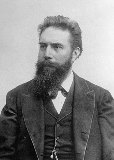X-radiation

W.C. Röntgen
- Characteristic X-radiation is created when an orbital electron jumps from one orbit to another with lower energy. This form of X-radiation has a discrete energy that is characteristic of the element in which it arises. In heavy atoms, emission of characteristic X-radiation is dominant, while in light atoms the Auger effect is more common.
- Bremsstrahlung occurs when an electron is accelerated or decelerated. This form of X-radiation has a continuous energy spectrum.